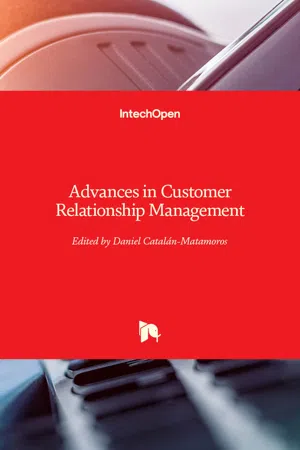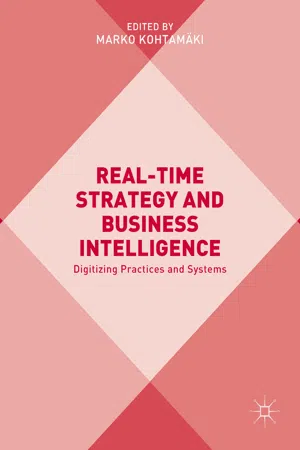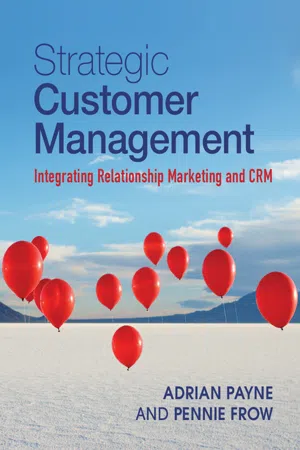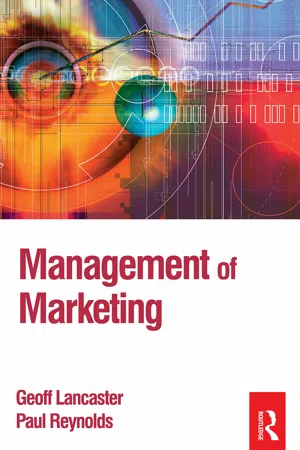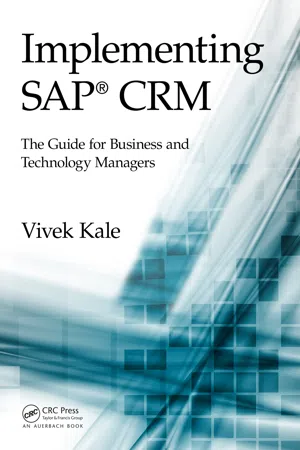Marketing
Customer Relationship Management
Customer Relationship Management (CRM) refers to the strategies and technologies used by companies to manage and analyze customer interactions and data throughout the customer lifecycle. The goal of CRM is to improve customer retention, streamline communication, and drive sales growth by understanding and meeting the needs of individual customers.
Written by Perlego with AI-assistance
Related key terms
1 of 5
11 Key excerpts on "Customer Relationship Management"
- eBook - PDF
- Daniel Catalan-Matamoros(Author)
- 2012(Publication Date)
- IntechOpen(Publisher)
1 An Overview to Customer Relationship Management Daniel Catalán-Matamoros The University of Almeria Spain 1. Introduction ‘‘[CRM] …isn’t a technology. As you will see, that’s true, but not strictly. I also heard that it was a ‘customerfacing’ system. That it is a strategy and/or a set of business processes. A methodology. It is all of the above or whichever you choose’’ (Greenberg, 2001, p. 4). Marketing historically has undergone various shifts in emphasis from production through sales to marketing orientation. However, the various orientations have failed to engage customers in meaningful relationship mutually beneficial to organisations and customers, with all forms of the shift still exhibiting the transactional approach inherit in traditional marketing (Kubil & Doku, 2010). However, Coltman (2006) indicates that in strategy and marketing literature, scholars have long suggested that a customer centred strategy is fundamental to competitive advantage and that Customer Relationship Management (CRM) programmes are increasingly being used by organisations to support the type of customer understanding and interdepartmental connectedness required to effectively execute a customer strategy. Customer Relationship Management (CRM) is a combination of people, processes and technology that seeks to understand a company's customers. It is an integrated approach to managing relationships by focusing on customer retention and relationship development. CRM has evolved from advances in information technology and organizational changes in customer-centric processes. Companies that successfully implement CRM will reap the rewards in customer loyalty and long run profitability. However, successful implementation is elusive to many companies, mostly because they do not understand that CRM requires company-wide, cross-functional, customer-focused business process re-engineering. - eBook - PDF
Real-time Strategy and Business Intelligence
Digitizing Practices and Systems
- Marko Kohtamäki(Author)
- 2017(Publication Date)
- Palgrave Macmillan(Publisher)
Introduction The conditions of doing business in today’s society are changing rapidly. To cope with such changes in the competitive landscape, companies are using different strategies and approaches to attract and retain customers and to successfully differentiate themselves from competitors. One such approach is Customer Relationship Management (CRM). Rooted in the domain of relationship marketing (e.g., Morgan and Hunt 1994; Palmatier et al. 2006), the CRM approach views customer relationships as (one of ) the most valuable and manageable assets of a firm (Thomas et al. 2004). Business Intelligence Within the Customer Relationship Management Sphere Jukka Partanen, Sharareh Mansouri Jajaee and Ossi Cavén © The Author(s) 2017 M. Kohtamäki (ed.), Real-time Strategy and Business Intelligence, DOI 10.1007/978-3-319-54846-3_7 123 J. Partanen (*) · S. Mansouri Jajaee Department of Management, University of Vaasa, Vaasa, Finland e-mail: [email protected] S. Mansouri Jajaee e-mail: [email protected] O. Cavén Procter & Gamble, Espoo, Finland e-mail: [email protected] 124 J. Partanen et al. As such, CRM, defined here as a strategic, customer-centric and IT-enabled approach that aims to build, manage, and retain long-term profitable customer relationships, has attracted a great deal of interest from both academics and executives (Plakoyiannakii 2005). More specifically, the past few decades have seen a dramatic increase in the acquisition of CRM-related systems and technologies. Understanding and responding to customer requirements and improv- ing customer service have become significant elements of corporate business strategy, and CRM systems are used by various types of organi- zations to support these strategies (Ali et al. 2013). Researchers also agree that usage of CRM systems has been growing exponentially over the past 10 years (Kalaignanam and Varadarajan 2012; Trainor et al. 2014). - eBook - PDF
- Joseph F. Hair, Jr., Rolph Anderson, Rajiv Mehta, Barry Babin(Authors)
- 2020(Publication Date)
- Wiley(Publisher)
62 CHAPTER 3 What Is CRM? Customer Relationship Management (CRM) is an essential sales management tool. CRM’s roots have been around for many years. As long ago as the 1960s, Reader’s Digest kept files on over 10,000,000 customers that were segmented into three groups based on the likelihood of their responding to promo- tional appeals. The system answered the question: “If a cus- tomer is sent a new book to review, how likely will they be to respond by purchasing the book and buying others?” One group was highly likely to respond, another group responded only with more prodding, and a third group was highly unlikely to respond. While primitive by today’s standards, this example captures the basic notion of CRM. 1 CRM includes a wide variety of business solutions for han- dling customer-related information. Thus, finding a univer- sally accepted definition of CRM is difficult. 2 Here, we focus on CRM from a sales and sales force management perspec- tive. In this context, CRM is a systematic integration of infor- mation technology and human resources designed to provide maximum value to customers and to obtain maximum value from customers for the company. 3 In other words, a CRM system helps salespeople match customers with the goods and services that are best for them, and in doing so, leveraging company resources into higher sales and profits. Today, more than ever, CRM depends on data. The ability to record, store, and analyze data about customers provides the fuel for successful CRM. Indeed, companies adopting CRM programs often, but not always, experience higher business performance. When CRM fails, the problem is seldom in the technology and more often in the human element, as we will see. As the name implies, CRM deals with managing relationships. Thus, just as people have different relationships with other people, businesses also have different rela- tionships with different customers. - eBook - PDF
Strategic Customer Management
Integrating Relationship Marketing and CRM
- Adrian Payne, Pennie Frow(Authors)
- 2013(Publication Date)
- Cambridge University Press(Publisher)
These relationships can be considered on a continuum ranging from an intimate partnership-type relationship, through to having no relationship at all with a given actor. The concept involves an enterprise offering value propositions which represent promises of value and maintaining relational exchanges aimed at co-creation of mutual value, long-term pro fi tability and shareholder value . Customer Relationship Management (CRM) The trends outlined above help explain why both relationship marketing and CRM have become so important. However, the problem faced by many organisations, both in deciding whether to adopt CRM and in proceeding to implement it, stems from the fact that there remains a great deal of confusion about what constitutes CRM. As a result, organisations often view CRM from a limited perspective or adopt CRM on a fragmented basis. This confusion surrounding CRM may be explained by: * the lack of a widely accepted and clear de fi nition of its role and operation within the organisation * an emphasis on information technology aspects rather than its bene fi ts in terms of building relationships with customers * the wide variety of tools and services being offered by information technology vendors, which are often sold as ‘ CRM ’ . STRATEGIC CUSTOMER MANAGEMENT 23 CRM builds on the principles of relationship marketing. However, with new market demands and new technologies, the management of customer relationships has been taken to a more complex level. CRM is a response to this new and more challenging environment. The huge scale and scope of the inter-and intra-organisational changes involved in CRM led Kotorov to claim that CRM was the third most signi fi cant revolution in the organisation of business after the invention of the factory in 1718 and the intro-duction of the assembly line into the factory production process in 1913. 34 Put very simply, CRM is ‘ information-enabled relationship marketing ’ . - eBook - PDF
- R. Kelly Rainer, Brad Prince, Hugh J. Watson(Authors)
- 2016(Publication Date)
- Wiley(Publisher)
By employing this approach, businesses can use information about each customer— for example, previous purchases, needs, and wants—to create highly individualized offers that customers are more likely to accept. The CRM approach is designed to achieve cus- tomer intimacy. Customer Relationship Management is a customer-focused and customer-driven organi- zational strategy. That is, organizations concentrate on assessing customers’ requirements for products and services and then providing a high-quality, responsive customer experience. CRM is not a process or a technology per se; rather, it is a customer-centric way of thinking and act- ing. The focus of modern organizations has shifed from conducting business transactions to managing customer relationships. In general, organizations recognize that customers are the core of a successful enterprise, and the success of the enterprise depends on efectively man- aging relationships with them. The CRM approach is enabled by information technology in the form of various systems and applications. However, CRM is not only about the sofware. Sometimes the problem with managing relationships is simply time and information. Old systems may contain the needed information, but this information may take too long to access and may not be usable across a variety of applications. The result is that companies have less time to spend with their customers. In contrast, modern CRM strategies and systems build sustainable long-term customer relationships that create value for the company as well as for the customer. That is, CRM helps companies acquire new customers and to retain and expand their relationships with profitable existing customers. Retaining customers is particularly important because repeat customers are the largest generator of revenue for an enterprise. - eBook - ePub
- Paul Reynolds, Geoff Lancaster(Authors)
- 2005(Publication Date)
- Routledge(Publisher)
CRM is a major part of many companies’ e-commerce strategy and their long-term ‘relationship marketing’ strategy. CRM is a business and technology discipline that helps firms in the acquisition and retention of their most important and profitable customers. Ideally, CRM systems help firms provide start to finish customer care, from initial acquisition of the customer, right through to product delivery and after-care service. CRM is rapidly evolving from being a technology-centred undertaking to a business-value endeavour. Organisations are moving away from seeing their customers simply as exploitable income sources to treating them as assets to be valued and nurtured. The value of customers is a long-term concept and lifetime value of customers is what is important. This is an important trend that represents the use of knowledge-management practices, such as the use of databases to capture and store comprehensive information about customers to build long-term, mutually beneficial, customer relationships. Companies need a CRM strategy because it helps them understand customer-acquisition and retention goals, which is the basis of relationship marketing practices. CRM also helps companies retain customers and increase profitability. CRM strategy helps companies co-ordinate the management of customer relationships across systems and strategic business units.CRM software can bring together data from disparate systems and business units to provide a holistic view of customers and a company’s relationship with them. It can help co-ordinate customer contact and relationships across channels (e.g. retail or WWW) by presenting a unified message regardless of the contact point. CRM strategies can be a defence against being the same as every other supplier and can allow the marketing firm to differentiate itself through superior service, for example, if a company manufactures a ‘commodity’ product like welding rods it can differentiate itself through better CRM and customer service. CRM is most effective when companies use proactive strategies to support the sales process through acquisition, retention, and development. Many businesses are moving to Web-based CRM, but this does not obviate personal interaction that is so crucial. Active CRM technology means that customers contacting a Web site for information can be followed up immediately by telephone or some other form of communication. A mixture of communications can be used from the Internet, telephone, direct mail and personal contact. - eBook - PDF
Implementing SAP® CRM
The Guide for Business and Technology Managers
- Vivek Kale(Author)
- 2014(Publication Date)
- Auerbach Publications(Publisher)
67 Chapter 2 Customer Relationship Management (CRM) System What is a Customer Relationship Management (CRM) system? Not only is there little agreement on what it really stands for, there is even less agreement on what constitutes a CRM system, how it should be used, the potential of profitability gain, the impact on customer loyalty, the costs involved, the personnel needed, and the training needed for the CRM personnel. CRM system characteristics are not limited to the CRM products and tools that are currently available in the market, and CRM is certainly not a technique or methodology. There is every reason to believe that the boundaries described for CRM in this book will be constantly enlarging in the coming years (see Section 2.2 “Anatomy of a CRM System”). 2.1 Introduction to Customer Relationship Management (CRM) Systems Notwithstanding all these caveats, a CRM system could be defined reasonably as follows: A Customer Relationship Management (CRM) System is a suite of pre-engineered, ready-to-implement, integrated application modules that focus on automating and optimizing all customer-centric and customer-responsive functions—sales, marketing, service, and support— of an enterprise and possessing the flexibility for configuring, customizing, and personalizing dynamically the delivered functionality of the package, through any channel of interaction, to suit even the specific requirements of an individual customer. CRM enables an enterprise to operate as a relationship-based, information-driven, integrated, enterprise-wide, process- oriented, real-time, and intelligent customer-centric and customer-responsive enterprise. CRM System applications provide the framework for executing the best practices in customer-facing activities; it provides a common platform for customer communication and inter-action. The use of CRM System applications helps in improving customer responsiveness and also provides a comprehensive view of the entire Customer Life Cycle. - eBook - ePub
Environment and Innovation
Strategies to Promote Growth and Sustainability
- Clara Inés Pardo Martínez, Alexander Cotte Poveda(Authors)
- 2021(Publication Date)
- CRC Press(Publisher)
Finally, it cannot be ignored that, from the point of view of their level of development or evolution as a person, the public is not homogenous, but plural and changing; so that for any professional of the marketing these words appear like a challenge: “are the marks those that have to aspire to the values of the consumers, in place of being the consumers who aspire to the values of the marks”. Table 7.1 shows digital transformation of digital marketing from incomplete to complete transformation taking into account focus, objective, digital strategy, CEO involvement, involved areas, type of innovation, change management, talent management, and culture. What is a CRM (Customer Relationship Marketing)? Bindi Bhullar, senior analyst at Gartner Group, says about the CRM that: “It’s a business strategy that places the customer as the heart of your company. Imagine what your company would be like if your client could redesign it to adapt it to their needs. This is the company you need to be. “The business consultant Accenture defines it as: “The continuous process of identifying, directing, developing, tracking, selling, serving and improving high-value relationships with Clients, so as to generate sustained growth and profits”. Relationship Marketing is a term that encompasses a wide range of concepts, conceives the business environment in a broad sense in which the existing relationships between the company and the players that surround it (suppliers, stakeholders, administration, etc.) are integrated. These relationships are formed by the phases within the process in which they are recognized under the terms of identifying, establishing, developing, maintaining, and finalising relationships between brands and people - eBook - PDF
Marketing for the Nonmarketing Executive
An Integrated Resource Management Guide for the 21st Century
- Norton Paley(Author)
- 2000(Publication Date)
- CRC Press(Publisher)
The savings alone from streamlining suppliers and distribution by using the Internet are estimated at 25% of the retail price of a car. Such a system is not unlike the ongoing methods Wal-Mart Stores uses to give suppliers responsibility for stocking its store shelves. Or the practices Dell Computer employs to fine-tune its ordering and manufacturing processes, with the result that it is able to custom assemble more than 25,000 different computer configurations for customers. Thus, Customer Relationship Management, together with the effective application of technology, becomes the optimum model for marketing in the Internet Age. Customer Relationship Management (CRM)* Key point: On-line markets are commerce sites on the public Internet that allow large communities of buyers and suppliers to “meet” and trade with each other. Central to the entire marketing process is building stronger, more profitable customer relationships. And one of the all-powerful strategies in transforming enterprises — large and small, regional and global — to become customer-focused is Customer Relationship Management (CRM). CRM pervades the entire organization and involves the alignment of initiatives such as e-commerce, sales force effectiveness, customer service, customer relation-ship planning, enterprise resource planning, and supply chain management. It is the proliferation of information technologies that makes these intricate alignments pos-sible. For example: • Tracking software and database programs record how many times Web visitors check out an advertisement or a product — and what they skip over. To do that, Web sites place tags, called cookies, on a visitor’s com-puter disk drive. These cookies, combined with on-line registrations, then add information collected from e-mails and phone inquiries placed by cus-tomers. Thus, the value of marketing on the Internet isn’t in the click-throughs; it’s in the data acquired. - David Frederick Ross, Frederick S. Weston, Stephen W.(Authors)
- 2010(Publication Date)
- CRC Press(Publisher)
Marketers must be careful to continuously research and document what is working and what is not by utilizing the analytical tools available within most CRM applica-tions. These tools should provide ongoing quantitative tracking of buying patterns, customer attitudes, and degrees of satisfaction for all market seg-ments and points of contact. One analyst recommends conducting focus groups at least once a year with the best and the worst customers, as well as the internal service staff [15]. Such a procedure will enable effective monitor-ing of the qualitative input to assist in massaging the quantitative results of performance metrics. 172 ◾ Introduction to Supply Chain Management Technologies The successful implementation of a customer-centric organization requires that everyone in the business be aware and prepared to execute the enterprise’s CRM strategy. Driving the CRM strategy requires, in turn, the firm support and active participation of senior management who needs to provide the vision and to focus the energies of the organization on communicating the CRM initiative to cus-tomers and partners as well as to the internal staff. Without such direction and sponsorship, most CRM programs will quickly decay and revert to previous “silo” operating methods. Applying Technology to CRM CRM can be divided into three major functions: marketing , the activities associated with creating company branding, identifying the customer, selecting product/service offerings, and designing promotions, advertising, and pricing; sales , the actual selling and distribution of products and services; and service , activities encompassing customer support, call-center management, and customer communication.- eBook - PDF
Introduction to e-Supply Chain Management
Engaging Technology to Build Market-Winning Business Partnerships
- David Frederick Ross(Author)
- 2002(Publication Date)
- CRC Press(Publisher)
Without such direction and sponsorship, most CRM programs will quickly decay and revert to previous “silo” operating methods. II. APPLYING TECHNOLOGY TO CRM CRM can be divided into three major functions: marketing , the activities associated with creating company branding, identifying the customer, selecting product/service offerings, and designing promotions, advertising, and pricing; sales , the actual sell-ing and distribution of products and services; and service , activities encompassing customer support, call-center management, and customer communication. Together, the mission of these functions is to inform the organization of who its customers are, how to better understand what customers want and need, what is to be the product and service mix to be taken to the market, and how to provide the ongoing services and values that provide pro Þ tability and expand relationships. These func-tions also detail the technologies that will be used to market to the customer base, conduct transactions, respond to customer service issues, collect marketplace met-rics, and format customer contact information for review and analysis. These func-tions also assist in the development of the strategies governing how the supply channel network is to be constructed and the nature of trading relationships. Finally, these functions should provide the entire organization with the information and motivation necessary to continuously reshape the enterprise’s perception of customer service, reengineer vestiges of “silo” management styles, and architect infrastruc-tures that foster customer collaboration. In the past, the functions of marketing, sales, and service were, at best, loosely connected with each other and utilized varying levels of technology to transact business, collect information, and communicate with the customer.
Index pages curate the most relevant extracts from our library of academic textbooks. They’ve been created using an in-house natural language model (NLM), each adding context and meaning to key research topics.
